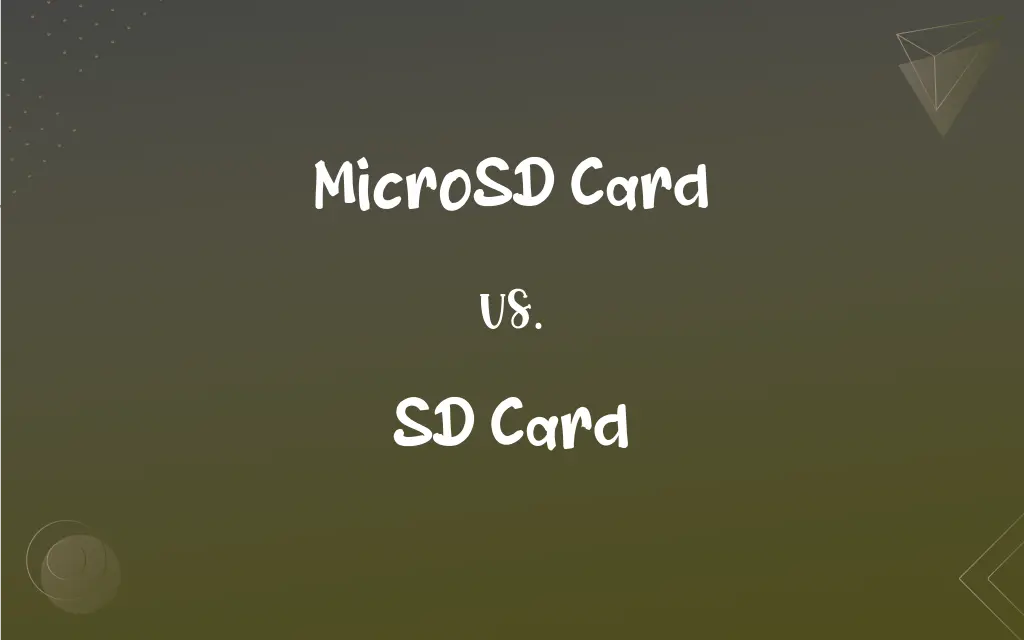MicroSD Card vs. SD Card: What's the Difference?
Edited by Aimie Carlson || By Harlon Moss || Published on January 26, 2024
MicroSD cards are smaller, portable memory cards primarily used in mobile devices, while SD cards are larger and commonly used in cameras and computers.

Key Differences
MicroSD cards are significantly smaller than SD cards, measuring just 15mm x 11mm, designed for use in compact devices like smartphones and drones. SD cards, on the other hand, are larger, measuring 32mm x 24mm, and are widely used in digital cameras and laptops.
Both microSD and SD cards come in various storage capacities. MicroSD cards typically range from 2GB to 1TB, catering to the storage needs of mobile devices. SD cards, however, often start at 2GB and can go up to 2TB, suitable for high-resolution photography and video recording.
The speed of microSD cards is crucial for smartphones and action cameras, with some offering ultra-high-speed (UHS) classifications. SD cards also offer varying speeds, with higher classes used in professional photography and video production to handle larger files and faster data transfer.
MicroSD cards, due to their small size, are built to be durable and often resistant to water, shock, and x-rays. SD cards, being larger, are also built tough but are more prone to physical damage due to their size and usage in devices like DSLRs.
The price of microSD cards can vary based on capacity and speed, generally affordable and widely available. SD cards, particularly those with high capacities and speeds, can be more expensive and are also readily available in electronics stores.
ADVERTISEMENT
Comparison Chart
Size
15mm x 11mm, smaller, for compact devices
32mm x 24mm, larger, for cameras and computers
Storage Capacity
Ranges from 2GB to 1TB
Ranges from 2GB to 2TB
Speed Classifications
Offers classes like UHS for fast performance
Speeds suited for professional use
Usage Scenarios
Ideal for mobile devices and drones
Common in digital cameras and laptops
Price Range
Generally more affordable
Can be more expensive for higher speeds
ADVERTISEMENT
MicroSD Card and SD Card Definitions
MicroSD Card
A compact flash memory card used in phones and cameras.
My drone uses a microSD card for storing videos.
SD Card
A common flash memory card used in various electronic devices.
My laptop has a slot for an SD card.
MicroSD Card
A tiny, removable storage module for data transfer.
I transferred files to my laptop using a microSD card.
SD Card
A digital storage medium widely used in photography and computing.
We store our professional photos on high-capacity SD cards.
MicroSD Card
A miniature storage device for digital data.
I saved the vacation photos on my microSD card.
SD Card
A portable and removable device for storing and transferring data.
I backed up my documents on an SD card.
MicroSD Card
A small, portable memory card for electronic devices.
I expanded my phone's storage with a 128GB microSD card.
SD Card
A durable and reliable memory card for electronic data.
My GPS navigator uses an SD card for map updates.
MicroSD Card
A diminutive and versatile digital storage solution.
I backup my contacts on a microSD card.
SD Card
A standard-sized memory card for digital data storage.
I bought a 64GB SD card for my digital camera.
FAQs
How is an SD card different from a microSD card?
An SD card is larger than a microSD card and commonly used in cameras and computers for data storage.
Are microSD cards slower than SD cards?
Not necessarily; the speed depends on the class and brand of the card, not its size.
What is a microSD card?
A microSD card is a small, portable memory card used primarily in mobile devices for storage expansion.
Can I use a microSD card in an SD card slot?
Yes, with an adapter, a microSD card can be used in an SD card slot.
Are all SD cards the same speed?
No, SD cards come in different speed classes, indicated by symbols like Class 10, UHS-I, UHS-II.
Are SD cards waterproof?
Many SD cards are water-resistant, but it varies by brand and model.
Do microSD cards come with adapters?
Some microSD cards are sold with SD adapters, allowing them to be used in devices requiring SD cards.
How long do microSD cards last?
MicroSD cards can last for years, but their lifespan depends on usage and quality.
Can I use an SD card in my smartphone?
Most smartphones require microSD cards due to their smaller size.
What does 'Class 10' on an SD card mean?
Class 10 indicates a minimum write speed of 10MB/s, suitable for full HD video recording.
Can microSD cards be used in cameras?
Yes, with an adapter, microSD cards can be used in most cameras that accept SD cards.
Are there different types of microSD cards?
Yes, including microSDHC (high capacity) and microSDXC (extended capacity).
Can I use the same SD card in multiple devices?
Yes, but it's recommended to format the card for each device for the best performance.
What's the maximum storage capacity of an SD card?
SD cards can have capacities up to 2TB, though commonly available ones are usually up to 512GB.
What's the fastest type of SD card available?
Currently, UHS-II cards are among the fastest available, offering speeds suitable for 4K video.
Do microSD cards affect the performance of a device?
The performance impact is minimal, but using a higher class card can improve data transfer speeds.
Can an SD card's data be recovered if deleted?
Yes, with the right software, it's often possible to recover deleted data from SD cards.
Do SD cards need to be formatted?
Yes, it's recommended to format SD cards in the device they will be used in for optimal performance.
What's the difference in cost between microSD and SD cards?
Generally, microSD cards are more affordable, but prices vary based on capacity and speed.
How do I care for my SD card?
Keep it clean, dry, and stored in a protective case when not in use.
About Author
Written by
Harlon MossHarlon is a seasoned quality moderator and accomplished content writer for Difference Wiki. An alumnus of the prestigious University of California, he earned his degree in Computer Science. Leveraging his academic background, Harlon brings a meticulous and informed perspective to his work, ensuring content accuracy and excellence.
Edited by
Aimie CarlsonAimie Carlson, holding a master's degree in English literature, is a fervent English language enthusiast. She lends her writing talents to Difference Wiki, a prominent website that specializes in comparisons, offering readers insightful analyses that both captivate and inform.































































